

40mm Grenade Launchers
M79 Hand Held - XM148 Colt Hand Held - AAI M203 Rifle Modification
M5 UH-1 "Hog" - M28A1 AH-1G "Cobra" Turret - M8 OH-6A "LOH"
see discussions of the 40mm variations - Bruce Karn Memories - Tom Dooling memories
see War Stories:: accidental 40mm Discharge Rick Arthur and accidental death of Ernest Ford.
...................................................................................................
a single-shot, shoulder-fired, break-action grenade launcher that fires a 40×46mm grenade

The 40mm grenade launcher, still in global military use in several variations today, emerged as one of the more evolutionary weapons introduced during the Vietnam War, transitioning from low velocity single-shot handheld variants to high velocity rapid-fire scout/attack helicopter weapon systems, and Centaurs embraced all variations.
Developed during the 1950s by the Springfield Armory, the M79 was the first of the hand held 40mm grenade launchers designed for infantry, replacing the limited-range rifle grenades, such as the M17 and M9-types, of World War II/Korea. With no counterpart in foreign arsenals, the M79 Grenade Launcher entered U.S. Army service in December 1960, with first deliveries made to units the following month. Over the next decade, five corporations, including Springfield Armory, manufactured 350,000 of the weapons for the U. S. service alone, and the preferred launcher remains in use today across the globe due to superior accuracy.
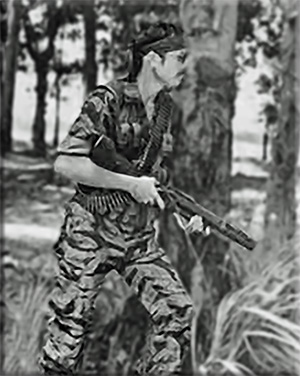 With a simple break-action breech loading sawed-off and rifled shotgun design, weighing about 6.5 pounds loaded, a grenadier could quickly master placing high explosive grenades with pinpoint deadly accuracy at targets up to 350 meters (385 yards), with a maximum range of 400 meters (440 yards). Infantry now had a weapon that effectively filled the gap beyond hand grenade range and danger close artillery/mortar coverage.
With a simple break-action breech loading sawed-off and rifled shotgun design, weighing about 6.5 pounds loaded, a grenadier could quickly master placing high explosive grenades with pinpoint deadly accuracy at targets up to 350 meters (385 yards), with a maximum range of 400 meters (440 yards). Infantry now had a weapon that effectively filled the gap beyond hand grenade range and danger close artillery/mortar coverage.
1971 Yearbook Lai Khe
Vest carried 14 rounds
The M406 40x46mm HE (high explosive) grenades fired from the M79, and other hand-held grenade launchers of the era, traveled at the low muzzle velocity of 75 meters (247 feet) per second. Fired from the rifled barrel, the round armed by a spin-activation safety feature after traveling between 14 (46 feet) and 27 meters (88 feet). On impact, 300 fragments could create injury within a 100 meter (328 feet) radius with an immediate kill zone from ground burst effect out to 5 meter (17 feet) radius.
On entering combat service in Vietnam, the 40mm M79 Grenade Launcher, fondly called "Thumper" or "Blooper", I became a force element with two assigned to each fire team organic to the Army 10-man rifle squads operating in the field. Aero-riflemen, or Blues, of both D Troop and F Troop utilized the M79 until departing country in 1973.
 Extensive Centaur photograph collections and yearbooks demonstrate that aircrews adopted the weapon, including the crews of OH-23s, the later OH-6s and UH-1s.
Extensive Centaur photograph collections and yearbooks demonstrate that aircrews adopted the weapon, including the crews of OH-23s, the later OH-6s and UH-1s.
As early as 1967, Scout William "Bill" Whitmoyer claimed "We installed a skid gun, gunner in the R door and someone with M-79 in the L door (photo to right)."
OH-6 Scouts of F Troop, 4th Air Cavalry carried the weapon in 1971 (below) and in 1972 (below right), but despite the availability of updated launchers, "Thumper" remained active until 1973.
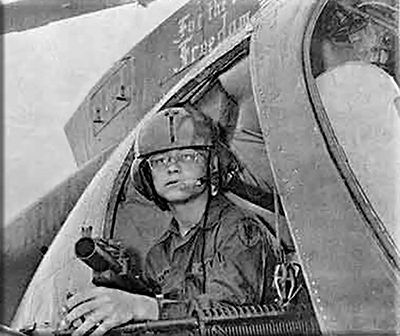

Although the M79 was an excellent weapon for covering that dead space not included under the umbrella of direct mortar or artillery fire, the rifle squad grenadiers utilizing "Thumper" as their primary weapon were restricted to the use of a side arm due to ammo load, also reducing the automatic firepower of the rifle squad.
In 1964, different developers began design of a single-shot 40mm launcher to be installed below the barrel of M16-type rifles, but the first model deployed proved problematic for field duty.
COLT XMI48 40MM Grenade Launcher
Designed by Colt's Manufacturing Company in 1964  as a replacement for the M79, this 40mm launcher, mounted to the M16 Rifle, would provide the rifle squad increased firepower with the added punch of the lethal grenade as direct fire support. In a contract with Colt Firearms, the Federal Government purchased 20,000 XM-148s in July 1966, and the weapon arrived in South Vietnam that December. By the following month, the Centaurs Aerorifle grenadiers received the modified M16 to replace "Thumper."
as a replacement for the M79, this 40mm launcher, mounted to the M16 Rifle, would provide the rifle squad increased firepower with the added punch of the lethal grenade as direct fire support. In a contract with Colt Firearms, the Federal Government purchased 20,000 XM-148s in July 1966, and the weapon arrived in South Vietnam that December. By the following month, the Centaurs Aerorifle grenadiers received the modified M16 to replace "Thumper."
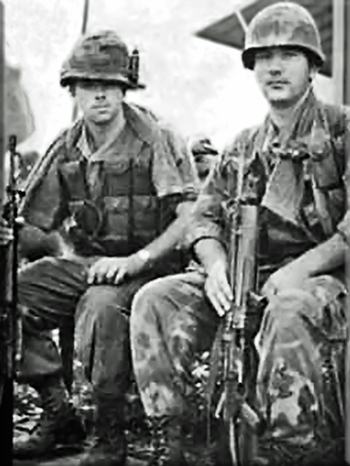
The 40mm grenade was breech loaded by sliding the barrel forward, armed by engaging the rear external cocking handle and fired by the extended trigger. The grenadier carried a nearly 6 pound weapon, with both loaded, and a normal combat load increased by ammunition for each weapon. With the same muzzle velocity of the M79, the manufacturers claimed the same maximum range of 400 meters (440 yards) and an effective range equal to "Thumper".
1970 Yearbook page 9 XM148
held by unknown Aerorifleman
Initial combat reports came in largely positive, but by March 1967, reviews on the experimental grenade launcher revealed a number of serious problems for active units in the field. Difficult to disassemble for cleaning, the launcher broke down to five major components requiring a number of small clips and cotter pins that were subject to loss in the field environment that could render the XM148 useless. The fragile extended trigger was extremely prone to breakage and with an average six pound trigger pull, the launcher became subject to accidental discharge from snagging if loaded while moving through heavy growth forest or underbrush.
By fall of 1967, the XM148 was pulled from field units to be relegated mostly to garrison service, but was adopted by the U. S. Air Force Security Forces for airfield duty in 1968, and some of the weapons remained in their armories until the 1990s. The next generation 40mm launcher/M16 combination proved up to the task, surviving in our military inventory as a major component of U. S. rifle squads today.
After poor reviews became known on the XM148 Grenade Launcher in early 1967, the AAI Corporation, formerly the Aircraft Armaments, Inc., produced a design of an under-barrel 40mm grenade launcher device for the M16 that was far less complicated than its predecessor, disassembled into four components for easy cleaning and proved most effective using the same ammunition against point targets, such as vehicle, bunker or other hard targets at 150 meters (160 yards), against area targets such as personnel out to 350 meters (385 yards) and maximum range of 400 meters (437 yards).
AAI M203 40mm Grenade Launcher 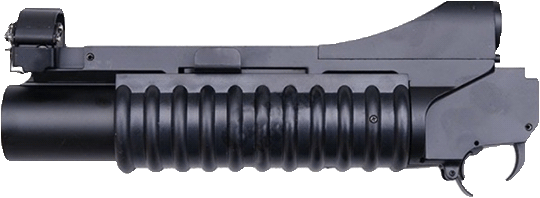
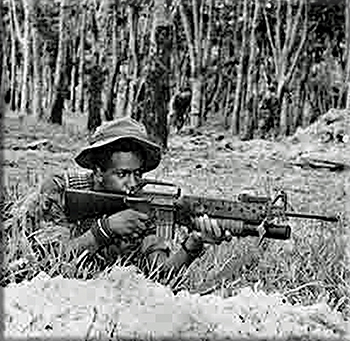 The M203 was accepted for Federal service in 1969, and in the following year, deliveries were made to the troops in Vietnam, including the Centaurs. This weapon fared well in Vietnam, and has been used in every conflict since then with a nearly fifty-year distinguished service record. Over the decades, seven different manufacturers, including Colt Defense built the M203, but the replacement is already in service.
The M203 was accepted for Federal service in 1969, and in the following year, deliveries were made to the troops in Vietnam, including the Centaurs. This weapon fared well in Vietnam, and has been used in every conflict since then with a nearly fifty-year distinguished service record. Over the decades, seven different manufacturers, including Colt Defense built the M203, but the replacement is already in service.
1971 Yearbook Lai Khe
unidentified
Aerorifle Grenadier
Since June 2017, the Marine Corps has already fielded the M320, and the Army will follow suit by 2020. Those who have utilized that M203 and the M79 will readily confess that "Thumper" had the superior combat performance.
40mm Launcher Munitions
In addition to the M406 40x46mm HE (HIGH-EXPLOSIVE ROUND) already described, all three infantry launchers utilized the following rounds during the Vietnam era:
M406 HE. Description: Olive drab aluminum skirt, steel projectile attached, gold markings, yellow ogive (round head).
M583A1 STAR PARACHUTE ROUND. Description: White impact or bar alloy aluminum round, with black markings used for illumination/signals with parachute to lower candle at 7 feet per second for 40 seconds of candle burns.
M576 BUCKSHOT ROUND. Description: Olive drab with black markings usewd as multipurpose anti-personnel canister round, effective in thick vegetated areas or for room clearing by utilizing twenty 24-grain metal pellets at a muzzle velocity of 269 meters per second. Later replacement rounds, the M576E1 (twenty 24-grain metal pellets) and the M576E2 (twenty-seven 24-grain metal pellets), were less effective because the shot spread out much more quickly than the M576 and could completely miss the target at shorter distances.
M651 CS ROUND. Description: Gray aluminum with a green casing, black markings, multipurpose round that arms between 10 and 30 meters, produces a white cloud of CS gas on impact and most effective for riot control and urban operations.
M5 40MM Grenade Launcher
of the M5 Armament System
of the UH-1 "Hog"

In the late 1950s, the Philco-Ford Corporation (later Ford Aerospace) began development of the M75 40mm Grenade Launcher, an "air-cooled, electrically powered, rapid firing weapon," for helicopter use, with the first being manufactured by the Springfield Armory, in Massachusetts. This reciprocating barrel and drum cam assembly grenade launcher, designed with a sustained rate of fire between 220 to 240 rounds per minute, was the first to utilize the high velocity M383/M384 High-Explosive 40x53mm Grenade created specifically to withstand the greater chamber pressures required for the increased firing rate of the aircraft weapon.
By late October 1962, extensive testing began at the Springfield Armory on the weapon mounted in a new turret system attached below the nose of a UH-1A. The system was adopted the following year and deployed to Vietnam in 1964 with UH-1As as the first Vietnam gunships of the Utility Tactical Transport Helicopter Company, a unit that went through several name changes through the entire war.
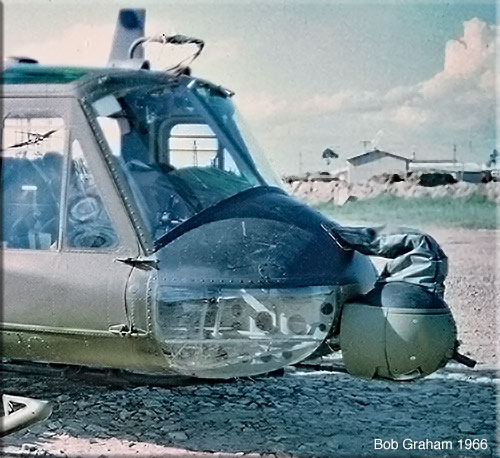 With the arrival of the Centaurs of D Troop, 3rd/4th Cavalry in 1966, they employed this first and only aircraft combat use of the 40mm M75 Grenade Launcher mounted in the M5 Armament Subsystem, a fully flexible servo-powered ball-turret attached under the nose of the UH-1C Huey ìHeavy Hogsî and braced to the airframe through the chin bubbles by three reinforcing struts. The turret internal components included the M75 launcher driven by a bracket mounted 5/8 horsepower 28 Volts DC motor, isolated from weapon recoil, and connected to the launcher by a flexible shaft. Each weapon cycle was controlled by an internal planetary gear train cam assembly that reduced motor speed in cycling rounds down to the gun at the desired rate and empty casings with links were ejected overboard through a chute system aimed down and away from the aircraft.
With the arrival of the Centaurs of D Troop, 3rd/4th Cavalry in 1966, they employed this first and only aircraft combat use of the 40mm M75 Grenade Launcher mounted in the M5 Armament Subsystem, a fully flexible servo-powered ball-turret attached under the nose of the UH-1C Huey ìHeavy Hogsî and braced to the airframe through the chin bubbles by three reinforcing struts. The turret internal components included the M75 launcher driven by a bracket mounted 5/8 horsepower 28 Volts DC motor, isolated from weapon recoil, and connected to the launcher by a flexible shaft. Each weapon cycle was controlled by an internal planetary gear train cam assembly that reduced motor speed in cycling rounds down to the gun at the desired rate and empty casings with links were ejected overboard through a chute system aimed down and away from the aircraft.
When initially deployed to combat, the nearly 500-pound system was limited to 150 linked grenades supplied by a 75-round ammo box in the rear cabin with an additional 75 rounds stored in the flexible chute fed to the grenade launcher by a motorized ammo booster. Later versions utilized larger capacity ammo cans, but the load of ammunition doubled with the installation of a 302-grenade rotary drum mounted in the cargo hook hole or bolted to the cargo deck.
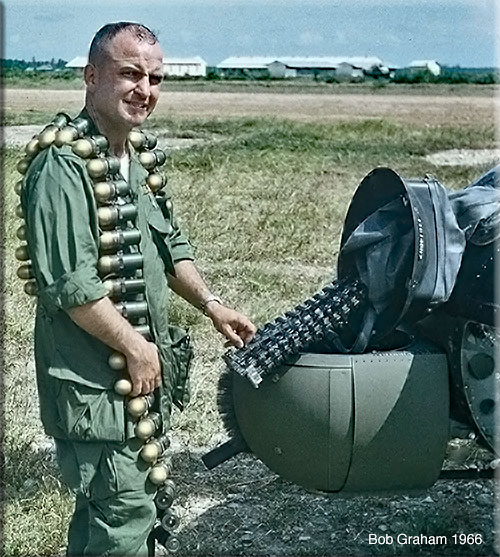 This rapid fire launcher, excellent for landing zone suppressive fire, could effectively place 40mm high explosive grenades, fired at 225 rounds per minute at a speed of 241 meters (790 feet) per second, on area or fixed targets out to 1,870 meters (2,057 yards), but proved most effective at around 1500 meters (1650 yards). A master armament control for the subsystem, located on the instrument console, was accessible to both pilot and copilot, and the weapon could be fired in stow position by the trigger switch on both cyclic stick grips. However, the copilot could operate the turret, sight and fire the system by a hand control reflex-type site assembly mounted above his seat.
This rapid fire launcher, excellent for landing zone suppressive fire, could effectively place 40mm high explosive grenades, fired at 225 rounds per minute at a speed of 241 meters (790 feet) per second, on area or fixed targets out to 1,870 meters (2,057 yards), but proved most effective at around 1500 meters (1650 yards). A master armament control for the subsystem, located on the instrument console, was accessible to both pilot and copilot, and the weapon could be fired in stow position by the trigger switch on both cyclic stick grips. However, the copilot could operate the turret, sight and fire the system by a hand control reflex-type site assembly mounted above his seat.
Among the drawbacks of the weapon was the excessive torque during firing cycles that occurred by positioning the cam assembly atop the barrel. This led to a long period of different barrel materials being tried to alleviate the rapid parts wear. The Army aircraft armament reports of 1964 deemed the basic design of the weapon inherently unsafe as it allowed for live rounds to be left in the breech after firing ceased. There were also reports of "run-away" conditions where the weapon mechanism functioned without gunner input. Despite the higher velocity of the grenades, pilots quickly learned to exercise extreme caution, especially in dives or treetop level, to avoid flying into their own shrapnel from the exploding grenades. This became true of any aircraft armed with all variants of 40mm grenade launchers.
of the M28A1 Armament System
AH-1G Cobra
 In August 1964, the U. S. Army placed an order for sixty-four of the new M75 Grenade Launchers, including spare parts, specifically for the M5 Armament Subsystem, but the year before, Philco-Ford Corporation design engineers began a modification program to cure those inherent problems of the newly-fielded 40mm launcher. By 1965, Philco-Ford began testing the refined weapon designated XM129, another cam-operated, electric motor driven, air-cooled, 40mm grenade launcher that greatly improved in performance.
In August 1964, the U. S. Army placed an order for sixty-four of the new M75 Grenade Launchers, including spare parts, specifically for the M5 Armament Subsystem, but the year before, Philco-Ford Corporation design engineers began a modification program to cure those inherent problems of the newly-fielded 40mm launcher. By 1965, Philco-Ford began testing the refined weapon designated XM129, another cam-operated, electric motor driven, air-cooled, 40mm grenade launcher that greatly improved in performance.
The excessive torque and parts wear created in the M75 design by the barrel being mounted below the operating drum was eliminated in the XM129 by the barrel being concentric with the drum, and had the added benefit of nearly doubling the rate of fire. To ensure no chambered live ordnance remained in the weapon, a dynamic braking system guaranteed the launcher barrel would always stop in the forward, or safe, position when the firing trigger was released.

As with the M75 launcher, designers created other XM129 40mm models; one for utilization as a ground weapon with a manual crank, and a model equipped with spade or butterfly grips for mounting on vehicles or aircraft, but neither were adopted. Instead, this weapon became an integral element for the worldís first helicopter designed solely as a weapons platform; the Bell AH-1G Cobra Attack Helicopter. Subsequently type classified as the M129, over 1,667 units were built by Philco-Ford before 1971 and by the Maremont Corporation from 1972 onward.
Although the M129 40mm grenade was known to be used almost exclusively as the new turret weapon paired with the minigun for the Cobra, references indicate it was deployed to Vietnam during the 1967-1968 period to some degree in a modified M5 turret for the Huey without stating which units in country were provided with the modification kits.
Corporate focus zeroed in on the weapon as one of two mounted in the next generation turret to replace the M5 Armament Subsystem. Ultimately, the M129 Grenade Launcher, paired on the left with the M134 7.62mm Minigun mounted right in the ìBî or Hybrid Configuration, became the dual weapons through a decade of service of the M28A1 Armament Subsystem, mounted below the nose of the new Cobra.
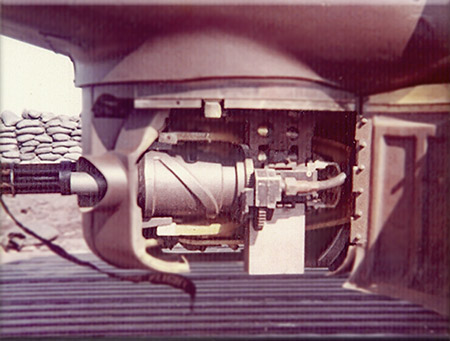 With a maximum rate of fire of 420 rounds per minute, the M129 was mounted in its own gun cradle assembly that included dual recoil adapters designed to provide recoil compensation during the 10-second bursts of the launcher that placed grenades 260 meters (850 feet) per second on targets out to 1,870 meters (2,045 yards). All expended casings and links were ejected below the aircraft through the chute in the rear of the weapon."
With a maximum rate of fire of 420 rounds per minute, the M129 was mounted in its own gun cradle assembly that included dual recoil adapters designed to provide recoil compensation during the 10-second bursts of the launcher that placed grenades 260 meters (850 feet) per second on targets out to 1,870 meters (2,045 yards). All expended casings and links were ejected below the aircraft through the chute in the rear of the weapon."
Including the mounting cradle and an overall length of 23.5-inches, with a 16.5-inch barrel, the launcher assembly weighed 43 pounds, 17 pounds heavier than the M75's 27 pounds, with an overall length 22.5 inches and a 13.7-inch barrel.
The cylindrical 40mm ammunition magazine assembly, containing approximately 265 linked grenades, located to the rear of the turret in the ammunition compartment below the front seat, was electrically driven by a booster motor mounted on the front of the magazine.
Comment by Lin Riniker: "I never saw a Cobra utilizing twin 40s. The instructors in the 45J course at Aberdeen told us it placed too much recoil stress on the turret and created hydraulic leaks. I could believe it considering the “thumping” just one M129 made when fired."
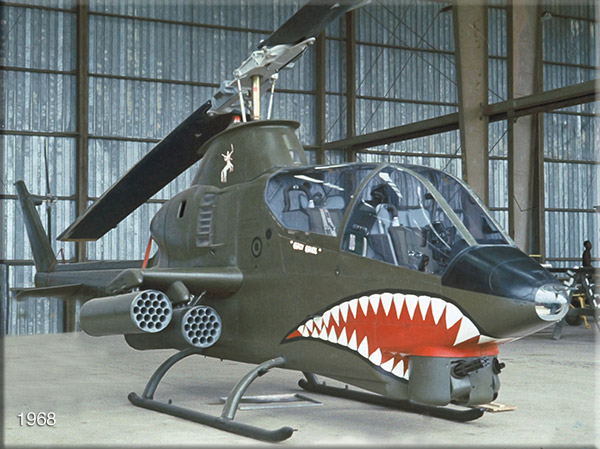 Seated in tandem, both the rear seated pilot and front seat gunner/copilot could fire the weapon in stowed position by the trigger switch on both cyclic control grips. However, the gunner/copilot could operate the turret as a fully flexible weapon system utilizing a floor mounted aircraft turret sighting station. The pilot utilized a fixed reflex sight mounted on the instrument panel bulkhead with approximately 28 inches from eye to sight. The gunner's armament control panel was mounted on the right console forward of the flight controls and the pilot's armament control panel was located on the center console above the wing stores panel.
Seated in tandem, both the rear seated pilot and front seat gunner/copilot could fire the weapon in stowed position by the trigger switch on both cyclic control grips. However, the gunner/copilot could operate the turret as a fully flexible weapon system utilizing a floor mounted aircraft turret sighting station. The pilot utilized a fixed reflex sight mounted on the instrument panel bulkhead with approximately 28 inches from eye to sight. The gunner's armament control panel was mounted on the right console forward of the flight controls and the pilot's armament control panel was located on the center console above the wing stores panel.
In early May 1968, nine AH-1G Cobras were delivered to Vung Tau designated for the 25th Division and six were assigned to the Centaurs on May 30, with turrets in ìBî Configuration. Over the years of service, the Centaurs utilized the different turret configurations, including the twin miniguns discussed elsewhere. This armament subsystem proved excellent at laying down rapid and voluminous area and point fire in attacks on personnel, lightly armored vehicles and unarmored material targets during escort and armed reconnaissance missions. By the time the Centaurs of F Troop were conducting operations, all turrets were configured with the M129 40mm on the left side.
of the M8 Armament System
OH-6A LOH
 The only other officially sanctioned Vietnam combat use of the M129 40mm grenade launcher in Army aircraft is believed to have been deployed by the Centaurs of D Troop, 3/4 Cavalry in 1969 as the experimental M8 Armament Subsystem on the OH-6A Loach. This 235 pound kit consisted of the M129 bracket-mounted on the left side of the fuselage and a 150-round ammunition container secured to the floor of the cargo hold behind the pilot.
The only other officially sanctioned Vietnam combat use of the M129 40mm grenade launcher in Army aircraft is believed to have been deployed by the Centaurs of D Troop, 3/4 Cavalry in 1969 as the experimental M8 Armament Subsystem on the OH-6A Loach. This 235 pound kit consisted of the M129 bracket-mounted on the left side of the fuselage and a 150-round ammunition container secured to the floor of the cargo hold behind the pilot.
Due to the short period of service in which this weapon system was deployed, very little technical information could be discovered. The weapon had the same range plus rate of fire as when used on the Cobra, but could only elevate 10 degrees and depress 24 degrees. It proved more practical to operate the weapon locked in the stowed position and bore-sighted to the given sighting system.
The M8 system kit included a M70/E1 reflex type beam splitter sighting mechanism, also used with the M27 7.62mm minigun for the Loach, but often remained packed due to the risk of head injuries in the confined area in the event of a crash. Grease pencil markings often replaced the sighting system in both systems.
Even with the lack of data on the M8 Armament Subsystem, Centaurs, as well as history, owe a debt of gratitude to Loach pilots Gary Jones and Bob Forringer who have provided first-hand accounts of the use of this system. The first link below provides the viewer a narrative about the system and by clicking on Bob Forringer's Video.
Bruce Karn Memories: There was a short period of time that we had two experimental 40mm systems. They worked super but if the pilot failed to elevate it before firing it the rounds impacted right in front of the aircraft and normally take out the chin bubble on the left side. (The XM-27 mini-gun on the left side would do it too if not elevated prior to firing.)
NOTES:
XM94 ARMAMENT SUBSYSTEM (1969-1975) U. S. Air Force Research and Development project for a door way compartment flexible pintle mount for the M129 40mm grenade launcher, with 800 rounds of ammunition, for use on the UH-1D/UH-1H/UH-1H/N "Huey.
M383/M384 HIGH-EXPLOSIVE 40MM HIGH VELOCITY GRENADE. Steel body yellow projectile, with metal rotating band press fitted with green aluminum case; round intended to produce personnel casualties in the target area using ground-burst effect; both the M383 HE and M384 HE contain 54.5 grams (approximately 1.9 ounces) composition A5 explosive filler; rounds only differ in type of steel composition of the projectile body; round fragmentation can produce a 5-meter (16 feet) kill radius and injury out to 100 meters (328 feet); M533 PD fuze threaded into projectile front end arms 18 meters (59 feet) to 36 meters (118 feet) from launcher. Used with the M75 and M129 40mm Grenade Launchers.
SOURCES:
Vietnam Choppers and Their Crews, Jonathan Bernstein/Gordon Rottman, Osprey Publishing Ltd. (2007).
Vietnam Order of Battle, Shelby L. Stanton, U. S. News Books (1986).
ST 23-2 Aircraft Armament Subsystem Photographs and Description, U.S. Army Armor School, Ft. Knox, Kentucky (May 1976).
Winged Sabers, The Air Cavalry in Vietnam, Lawrence H. Johnson III, Stackpole Books (1990).
Vietnam, The Helicopter War, Philip D. Chinnery, Naval Institute Press (1991).
Modern Military Aircraft, HUEY, by Lou Drendel, Squadron/Signal Publications (1983).
The Vietnam Experience, Tools of War, Edgar C. Doleman, Jr., Boston Publishing Company (1985).
Vietnam Order of Battle, Shelby L. Stanton, U. S. News Books (1986).
Vietnam Warriors, Charles Melson and Gordon Rottman, Osprey Publishing Limited (2006).
https:/en.wikipedia.org/wiki/M79_grenade_launcher
https:/en.wikipedia.org/wiki/XM148_grenade_launcher
Modern Military Aircraft, HUEY, by Lou Drendel, Squadron/Signal Publications (1983).
TM 9-1090-203-12, Operator and Organizational Maintenance Manual: Armament Subsystem Helicopter, 7.62mm Machine Gunó40mm Grenade Launcher: M28A1 (1090-00-134-3071) (used on AH-1G Helicopter) Headquarters, Department of the Army (January 1976).
UH-1 Huey In Action, by Wayne Mutza & Gunslingers In Action, by Lou Drendel, (A 2-in-1 Volume), Squadron/Signal Publications (1986).
Unintentionally Iconic: The Armyís UH-1 Gunship, Joseph Trevithick at:
http:/smallarmsreview.com/display.article.cfm?idarticles=2089
THE MACHINE GUN. Vol. V., George M. Chinn, Edwards Brothers Publishing Co., Ann Arbor, Michigan (1987) at:
http://www.securityarms.com/20010315/galleryfiles/3000/3095.htm
M129 40mm Grenade Launcher at: https:/en.wikipedia.org/wiki/M129_grenade_launcher
...................................................................................................
Discussions of 40mm Variations
Jim Hoag (Jul2019): In regards to the 40mm grenade launcher I vaguely remember one of the loach guys had acquired and mounted a handcrank Honeywell 40mm. I'm guessing he acquired it somehow from the Navy as they used them on their gunboats in the Delta.
Here's some info on them especially header picture: http://www.smallarmsreview.com/display.article.cfm?idarticles=2451
The triangle mount would not have been used by the Navy on their gunboats. I just attached it for a different view.
Mike Peake (Jul2019): Regarding Memory Jogger item MJ050 - (8 Jul 2019): I very much appreciate Jim Hoag's input on the 40mm grenade launchers, especially since it makes me know I may not be totally Looney-Tunes. When I started researching all the Centaur photo collections for armament related images for the minigun, I believe, I could've sworn that in possibly a collection that had not been posted to the main site, one image included what I thought was a Centaur UH-1 with what I recognized as the MK19. I filed it away in the brain pan for when I got to the 40mm, but made the amateur error of not footnoting the location. Naturally, I haven't been able to find that image since.
The MK18 and MK20 must be Honeywell's designation for different modifications but what was fielded by the U.S. Navy was the MK19. Both those designations are now assigned to handheld small arms developed by the U.S. Navy. I know that it was absolutely post-1970 and likely during the transition to F Troop, because the Navy didn't mount the MK19 MOD1 on swift boats, etc., until supposedly 1972 (although I believe it was combat tested before that given the MOD0 came out in 1966, but was unreliable). We overhauled/manufactured the MK19 MOD 3, still in use by multiple services, at Naval Ordnance Station-Louisville from about 1986 on, and the U. S. Army adopted the weapon in 1983. BETTER grenades now too. Just going from memory, I believe the Air Force may door-mount them in their special operations unit.
Jim Hoag: The Honeywell I vaguely remember was somehow mounted on an OH-6A, not a UH-1. It was near the end of my tour after we had moved to Lai Khe as F Trp. I departed in June 1970.
Lin Riniker: OK guys, all this discussion of 40mm grenade launchers brought back a memory of something puzzling I found. I had just arrived at Long Binh and was cleaning out a conex full of junk parts in the armament tent when I came across a revolver type grenade launcher similar to what is in the photo. I asked what it was and SP5 Callahan, who was the NCOIC of armament at that time, replied it was a “Honeywell”. It was beyond salvage so I took a hammer to further demil it and it went with the rest of the junk. The launcher I modified in the pic is made in S. Africa. I don’t recall any markings on it. It is amazing what was experimented with in that war.